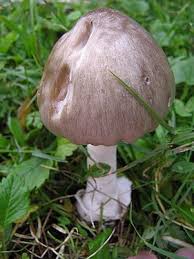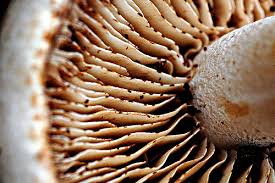Mushroom Volva refers to a specific feature found in some species of mushrooms. The volva is a cup-like or structure that surrounds the base of the mushroom’s stem, often referred to as the stipe. It is typically found underground or partially buried in the substrate where the mushroom grows.
The volva is a remnant of the universal veil, a protective membrane that encloses the entire mushroom when it is in its early stages of development. As the mushroom cap expands and matures, the veil either ruptures or opens up, leaving behind traces of the universal veil in different forms. One of these forms is the volva.
The appearance of the volva can vary significantly depending on the species of mushroom. In some cases, it may resemble a sac or a cup, while in others, it could take the form of distinct patches or scales around the base of the stem. The color and texture of the volva can also vary, ranging from white, yellow, or brown, to more fibrous or gelatinous in texture.
The presence and characteristics of the volva are essential features in mushroom identification and classification, as they can help differentiate between various species. It is especially significant in the identification of some Amanita species, which are known for having prominent and distinctive volvas. However, not all mushroom species have a visible volva, so its absence does not necessarily indicate a different species.
Economic Importance, Uses, and By-Products of Mushroom Volva


Some of the economic importance and uses of mushrooms Volvo include:
1. Food and Culinary Use: Many mushroom species are edible and serve as a valuable source of nutrition and flavor in culinary dishes. Popular edible mushrooms include button mushrooms (Agaricus bisporus), shiitake mushrooms (Lentinula edodes), oyster mushrooms (Pleurotus ostreatus), etc.
2. Medicinal and Nutraceutical Uses: Certain mushroom species have medicinal properties and are used in traditional medicine and modern pharmaceutical research. For example, the reishi mushroom (Ganoderma lucidum) is believed to have immune-boosting properties.
3. Bioremediation: Some mushrooms can break down and detoxify various pollutants, making them useful in bioremediation efforts to clean up contaminated environments.
4. Agricultural and Horticultural Use: Mushroom cultivation is a significant agricultural activity, and mushrooms are grown commercially for food consumption. Additionally, mushroom compost can be used as a beneficial soil amendment in horticulture.
6. Industrial Uses: Mushrooms and their mycelium (the thread-like structures of fungi) can be used to produce enzymes, organic acids, and other industrial products.
7. Volva (Volva in Mushroom Anatomy): The volva is a specific feature found in some mushroom species. It is a cup-like structure at the base of the mushroom that surrounds the base of the stem. The volva is often formed during the early stages of mushroom development and can persist or degrade as the mushroom matures. Its economic importance and uses, if any, are not distinct from the general economic importance of mushrooms as a whole.
8. Biotechnology and Bioengineering: Mushrooms have significant potential in biotechnology and bioengineering. Fungal enzymes can be used in various industrial processes, such as the production of biofuels, textile manufacturing, and pharmaceuticals. For example, the enzyme laccase, extracted from certain mushroom species, is used in the treatment of industrial wastewater and in the production of paper and pulp.
9. Cosmetics and Skincare: Mushrooms are increasingly being used in the cosmetics and skincare industry due to their beneficial properties. Extracts from certain mushrooms like the shiitake and chaga are rich in antioxidants and may have anti-aging and skin-soothing effects.
10. Biodegradable Packaging: Mycelium, the root-like structure of mushrooms, can be used as a sustainable and biodegradable alternative to traditional packaging materials like Styrofoam. Companies are exploring the use of mycelium-based packaging as an eco-friendly solution to reduce plastic waste.
Read Also : Economic Importance, Uses, and By-Products of Mushroom Hyphae
11. Nutritional Supplements: Some mushroom species are used to produce dietary supplements. For instance, cordyceps and lion’s mane supplements are claimed to have potential cognitive and energy-enhancing benefits, respectively.
12. Mycoremediation: Beyond bioremediation, mycoremediation refers to the use of mushrooms and their mycelium to break down and remove various pollutants and toxins from the environment, such as oil spills, pesticides, and heavy metals.
13. Traditional Medicine: Mushrooms have been used in traditional medicine systems for centuries. In traditional Chinese medicine, various mushrooms are believed to have therapeutic properties and are used to treat different ailments.
14. Forest Ecology and Soil Health: Mushrooms play a crucial role in forest ecosystems, breaking down organic matter and contributing to nutrient cycling. They form symbiotic relationships with trees and plants, enhancing soil health and promoting healthy forest growth.
15. Culinary Exports: Mushroom cultivation can be a profitable export business in some regions. Countries with favorable climates for mushroom production often export gourmet or specialty mushrooms to meet international culinary demands.
16. Myco-Construction: Research is being conducted to explore the possibility of using mycelium-based materials in construction. Mycelium can be grown into specific shapes and structures, potentially revolutionizing the building industry with eco-friendly and sustainable materials.
In summary, mushrooms have a diverse range of economic importance and practical uses, ranging from food and medicine to industrial applications and environmental remediation. As research and innovation continue, we can expect to uncover even more applications for this fascinating group of organisms.
The Products and By-products That Can Be Derived From Mushroom Volva
Mushrooms are highly versatile organisms that can be utilized in various ways. They can be consumed as food, used for medicinal purposes, and even play a role in various industrial processes. Here are some common products and by-products that can be derived from mushrooms:
1. Edible Mushrooms: Many mushroom species are consumed as food. Some popular edible mushrooms include button mushrooms (Agaricus bisporus), shiitake mushrooms (Lentinula edodes), oyster mushrooms (Pleurotus ostreatus), and portobello mushrooms (Agaricus bisporus, mature form).
2. Medicinal Extracts: Certain mushrooms are known for their medicinal properties. For instance, reishi mushrooms (Ganoderma lucidum) are used in traditional medicine for immune support, lion’s mane mushrooms (Hericium erinaceus) for cognitive health, and chaga mushrooms (Inonotus obliquus) for their antioxidant properties.
3. Mushroom Powder and Extracts: Mushrooms can be processed into powder or extracts, which are used as supplements or added to various products like teas, coffees, and health drinks.
4. Mycelium-Based Products: Mycelium is the root-like structure of mushrooms and can be used to create various products, including mycelium-based leather substitutes, packaging materials, and even building materials.
5. Mushroom-Based Dyes: Some mushroom species contain natural pigments that can be used as dyes for fabrics and other materials.
6. Biodegradable Materials: Mushroom mycelium can be combined with agricultural waste to create biodegradable materials, such as packaging materials and insulation.
7. Compost and Fertilizers: The spent mushroom substrate (the material left after the mushrooms are harvested) can be used as compost or fertilizer due to its nutrient-rich composition.
8. Mushroom-Based Biofuels: Research is ongoing to explore the potential of using mushrooms to produce biofuels.
9. Mushroom-Based Cosmetics: Some mushrooms contain compounds beneficial for the skin, such as beta-glucans and antioxidants. These properties are utilized in the production of skincare products like creams, serums, and masks.
10. Enzymes and Bioactive Compounds: Mushrooms are a source of various enzymes and bioactive compounds that have industrial applications. For example, some mushroom enzymes are used in the food and beverage industry for flavor enhancement and clarification processes.
Read Also : Economic Importance, Uses, and By-Products of Mushroom Mycelium
11. Mushroom Flavors and Seasonings: Dried and powdered mushrooms, such as porcini mushrooms, are popular for adding umami flavor to dishes and can be used as natural seasonings.
12. Animal Feed: Some mushroom by-products, like spent mushroom substrate, can be used as animal feed due to their nutritional content.
13. Bioremediation: Certain mushroom species, such as oyster mushrooms, have been found to be effective in bioremediation, meaning they can help in the cleanup of environmental pollutants and contaminants.
14. Cultivation Substrates: Mushroom cultivation often involves the use of various substrates, such as sawdust, agricultural waste, and coffee grounds. These substrates can sometimes be repurposed or composted after mushroom harvest.
15. Mycoremediation: In addition to bioremediation, mushrooms can be employed in mycoremediation processes to break down and degrade various pollutants and toxins in the environment.
16. Medicinal Capsules and Extracts: Medicinal mushroom extracts are also available in the form of capsules or tinctures for ease of consumption and standardized dosage.
17. Mushroom Beverages: Certain mushroom varieties, like chaga and reishi, are used in the production of mushroom-infused beverages, such as teas and coffees, which are touted for their health benefits.
18. Mushroom Vinegar and Sauces: Some cultures make use of mushrooms to create unique vinegar or sauce varieties with distinct flavors.
It’s worth mentioning that mushroom-related research and applications are continually evolving, and new uses and products are regularly being discovered and developed. Additionally, while mushrooms offer numerous benefits and potential applications, proper identification, safe cultivation, and responsible harvesting practices are essential to avoid potential risks associated with wild mushroom toxicity or habitat disruption.
Read Also : All You Need To Know About Regenerative Agriculture
